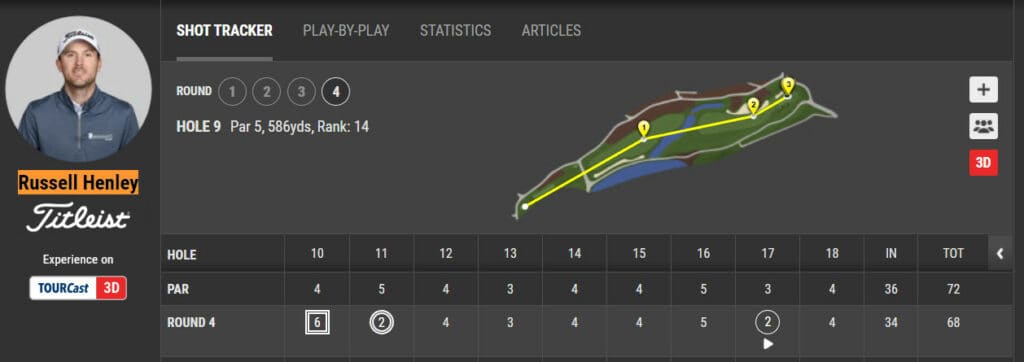- Updated: February 1, 2023
What is an Eagle in Golf?
Scoring an Eagle in golf means the player gets the ball in the hole in two strokes under Par.
An “Eagle” in golf is one of the most coveted and challenging to achieve feats in the game, with professional golfers and highly skilled players performing them way more often than most.
There are an enormous amount of “golfing terms” that often relate to a rare occurrence or significant accomplishment when playing. Unfortunately, these terms aren’t always straightforward to understand and can often leave the average golfer, beginner, or casual fan confused.
If you want to know more about what an “Eagle” means and how you might achieve a few, keep reading.

How Many Strokes Does it Take to Score an "Eagle?"
We’ve established that scoring an Eagle on a hole essentially refers to shooting two strokes under a hole’s “Par.”
This means to score an Eagle, you would need to shoot:
Single Stroke on a Par 3
This is most commonly referred to as a “Hole in One” but is also technically an Eagle at the same time.
The odds of an average player making a Hole in One are 12,000 to 1, while the odds of an average player making an Eagle are roughly 1,000 to 1. This shows a Hole in One is extremely rare, even compared to the challenging Eagle.
Two Strokes on a Par 4
These types of Eagles are usually the result of driving the green and making the putt, holing a longer approach shot, or chipping in from off the green.
This type of Eagle is easier than the previously mentioned kind (obviously) but is exponentially more challenging than the following type of Eagle we’re discussing.
Three Strokes on a Par 5
The vast majority of Eagles are scored and carded this way. Players with a solid driving ability off the tee and enough distance and accuracy with longer approach shots can find the green in two strokes and make their putt for three shots total, resulting in an Eagle.
Additionally, players will often have more opportunities throughout a season to chip in from close range for Eagle on a Par 5 than on Par 4’s because driving close to the green on Par 4’s is more challenging to achieve than hitting approach shots on Par 5’s to a closer distance.
Where Did the Term "Eagle" Come From?
According to the United States Golf Association (USGA), the term “Eagle” in golf originated in the United States in the very early 1900s as the natural progression from a “Birdie.”
In the 19th century, Americans referred to anyone or anything excellent or outstanding as “bird.”
Once the term “Birdie” was established to mean “One stroke under par for a given hole,” the word “Eagle” soon became common to refer to a score one better than a “Bird.”
These “bird” related terms have continued to be used in Golf vocabulary over the last 120 years and have become staple phrases of the sport. These are just a few of the many golf-related terms beginners and casual fans should commit to memory to fully understand the game and its scoring.
How Rare is an Eagle?
Depending on your resource, there are multiple “odds of an Eagle” floating around online.
As someone that’s been playing golf for the last 15 years reasonably regularly, I’d like to say my game’s suitable for an Eagle per year, but that might be a generous estimation.
According to the exceptionally well-kept PGA Tour Statistics recorded through ShotLink, the number of Eagles recorded last year (2022) on the Tour averaged out to only two Eagles per professional player.
Hitting the green of a Par 5 in two shots or driving the green in one shot on a Par 4 is a difficult enough task in its own right, and those are just the beginning steps to making an Eagle! This accomplishment is difficult for even an expert golfer and should be celebrated when achieved by most all amateur players.
Which PGA Tour Player Makes the Most Eagles?
As of the conclusion of the 2022 PGA Tour Professional season, Patrick Rodgers played 89 rounds and carded 21 birdies.
This is a significant jump in Eagles made by the leader of the “Total Eagles” category every year, with Cam Davis being the leader in 2021, carding 20 Eagles, and Collin Morikawa being the leader in 2020 with only 16.
When to Attempt an Eagle?
As we’ve already discussed, making a “big birdie” or Eagle is highly uncommon, but that doesn’t mean you can’t make any.
The best times for average golfers to attempt making Eagles are on Par 4’s and Par 5’s but specifically shorter holes in those two categories.
Below we outline some of the instances where Eagles will be easier to come by and discuss some of the ways our fellow golfers can maximize their odds of making one.
How to Try to Make More Eagles?
There are a few things golfers can do to increase their chances of making more Eagles. Besides the obvious advantage of playing from closer tees, we outline a few things players can consider to score this rare bird more easily below.
Become More Precise with Your Approach Clubs (Long Irons, Fairway Woods)
We’ve distinguished that the easiest Eagles happen on Par 5’s, but to achieve these Eagles, you have to hit a superb approach shot to set up the opportunity.
First, you must define and commit to memory your carry-yardages with these “approach clubs.” Since these clubs go the furthest besides players’ drivers, it will likely take some type of Launch Monitor to get these numbers accurately.
Then all that’s left to do is get accurate and confident with these clubs. Having the ability to hit closer approach shots from long distances turns longer holes into “scoring opportunities” in your mind instead of worrying about turning it into a “blow-up hole.”
Practice Hitting the Ball Further
Just within the last few years, PGA Tour players, lower-level professionals, and aspiring amateurs everywhere have begun to chase further distance off the tee and faster ball speeds.
Greater drive distance makes shorter Par 4’s and Par 5’s much easier to reach to give players the opportunity of making an Eagle, but how can our readers get faster?
The easiest way to get faster is to learn to swing more quickly. This can be achieved by using a Swing Speed training tool like the Super Speed Golf Training Aid that we’ve reviewed on our site and is used by over 700+ touring players around the world.
A more difficult way to hit the ball further is by focusing on “golf swing-specific workouts” in the gym. Many of these exercises in the golf world focus on explosive power/movement, balance, and flexibility—all critical components to hitting the ball further.
Lower Your Expectations
We’ve already discussed the odds of making an Eagle in golf are unbelievably rare for amateurs, and even PGA Tour players average only 2 eagles per year of competitive play.
If you go out to the golf course every round and focus on making Eagles, you’re losing sight of the overall goals of shooting a decent score for your whole round and having a good time while doing it.
Stay patient with your game and celebrate Eagles for the very rare bird they are!
What Style of Hole Results in the Most Eagles?
As we mentioned earlier, shorter Par 5’s that are easily reachable in two shots provide players with the most opportunities to score an Eagle.
That being said, there are some holes with natural terrain that allows Eagles to happen more frequently. These natural features include things like fast fairways, bowled greens that funnel the ball closer to the hole once the ball reaches the putting surface, or the wind direction making drives and tee shots much longer than usual.
What Golf Hole Gets The Most Eagles on the PGA Tour?
The photo above is of the Par 5 fifth hole at the Plantation Course in Kapalua, Hawaii.
While the hole does stretch considerably over 500 yards, the tee shot is so significantly downhill, and balls will see so much rollout that many players will have nothing more than a wedge or scoring iron into the green.
Last year during the first round of the Tournament of Champions at the Plantation Course, out of the 38 players in the field, 35 made Birdie or Eagle, 2 players made Par, and only one player, Patrick Reed, made Bogey.

This 5th at Kapalua has widely been regarded as the “easiest hole on the PGA Tour” for the last handful of years, and with scoring on the hole consistently averaging close to one shot under Par, we don’t see that title going away any time soon.
What Shape is Used to Mark an Eagle on the Scorecard?
While other countries mark their scorecards or show scoring on television differently, in the United States, an Eagle is represented on the scorecard with two circles around whatever the number may be.
For example, we’ve included a photo of the back nine of a round PGA Tour Pro Russell Henley played not too long ago.
As you’ll notice, he began his back nine with a Double Bogey on the 10th hole (represented by two squares around his score of 6 on that Par 4), followed that with an Eagle on his next hole, the 11th (noted by two circles around his score of 2 on a Par 5), and then finished his round with all Pars and a Birdie on 17 (shown as a circle around his score of 2 on a Par 3).
That’s a very interesting way to shoot -1 for nine holes.

Is There Anything Better Than an Eagle in Golf?
There are a few achievements in golf that are an even rarer occurrence than scoring an Eagle.
We already discussed that a Hole in One is over 10 times less likely than an Eagle.
Additionally, shooting three strokes under Par for a given hole is called an Albatross or “Double Eagle,” and shooting four strokes under Par for a given hole (essentially only making a Hole in One on a Par 5) is called an even rarer sibling to the Albatross, a “Condor.”
Golf terms are odd, and golf etiquette can seem even more strange at times, but these little nuances of the game make golf so unique (and challenging).
Dustin Johnsons Eagle Performance at Augusta National
While most professional golfers would be thrilled with a single Eagle shot during a round at the Masters, in 2015, Dustin Johnson set the Master’s Tournament record with the most recorded Eagles in a single round.
During his second round of the 2015 Masters Tournament, Dustin Johnson made THREE Eagles in a single round, carding one on the 2nd, 8th, and 15th holes.
While Dustin didn’t go on to win the 2015 Masters Tournament, he did secure an asterisk-marked Masters Victory in 2020 when the tournament was held in November instead of the usual April date due to the beginning of the COVID-19 craze.

About The Author
Writers of Independent Golf Reviews
Independent Golf Reviews has tested and reviewed 1000+ golf products over the past 10 years. We use our experience and expertise to give golfers an unbiased insight on the market.
Read more…
Share
Receive the best golf discounts available exclusively for our subscribers and be auto entered into our monthly golf giveaways!
Success!⛳️
You are now an official member of IGR. Keep an eye out for the perks.
No spam, ever. 🔒

